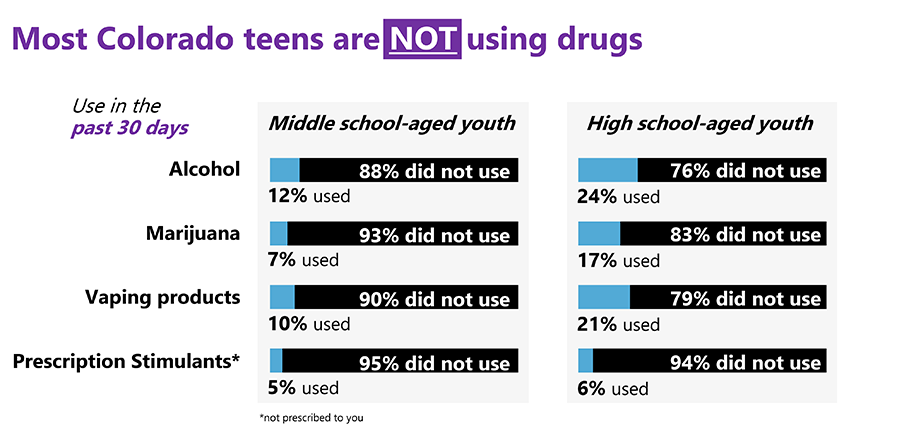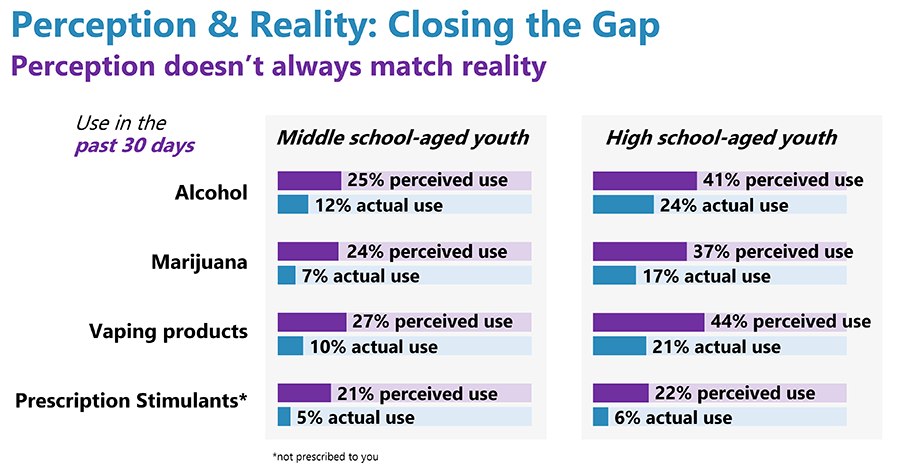FILL YOUR WORLD WITH GOOD is a social norms campaign based on specific questions from the Rise Above Colorado Youth Survey. When it comes to substance misuse, teens sometimes hold inaccurate ideas of how many of their peers are actually using alcohol and other drugs. The social norms approach is about closing the gap between people’s misperception and reality.1 Peer pressure, distorted representations of youth in pop culture, and false notions that “everyone is doing it” or that “experimentation is just part of being a teenager” can negatively shape the way we see our world, influencing how we make our day to day decisions. In turn, holding accurate perceptions, knowing for instance that in reality most teens don’t use alcohol and other drugs, makes embracing healthy choices easier because we know other youth are prioritizing their health and future, too.
Do misperceptions about substance misuse exist among Colorado teens?
Our first step developing this campaign was determining if gaps exist between teens’ perceptions and reality and, if so, how common misperceptions are. The following Rise Above Colorado Youth Survey questions were prioritized to determine the need and value of a social norming campaign:


Administered by trained professionals, teen participants anonymously reported their own use, which was then compared to their estimates of their peers’ use in the past 30 days. The above graphs display the data for the responses to these two survey questions for middle school youth (12-14 year olds) and high school youth (15-17 year olds).
As the chart above indicates, research continues to show that Colorado teens are overwhelmingly NOT using alcohol and other drugs.
What is a survey?
Surveys are a research tool developed to collect information about specific topics from a representative sample.2 Surveys can be conducted through paper/pencil questionnaires, online forms, or by an interview.
What is the Rise Above Colorado Youth Survey?
The Rise Above Colorado Youth Survey (RAC Youth Survey) addresses behavioral health, which is defined as social, emotional and mental health and substance misuse. The survey also examines risk and protective factors for behavioral health. Risk and protective factors are individual, familial or community characteristics that research has shown contribute to either positive or negative health outcomes.3

I don’t remember getting surveyed...who participated?
Research panel recruitment, the process used to select teens to participate in surveys, uses a model focused on ensuring a large database of diverse participants so that researchers can access their target population.
Surveys can’t reach everyone because of time and money. More importantly, it’s not necessary if you chose a representative sample, or subgroup, to survey correctly. Research panel recruitment professionals help to ensure the survey reaches the correct sample of people. In this case, “correct” most often means two things:
Is the RAC Youth Survey sample size large enough?
Over 700 Colorado teens were surveyed in the 2022 RAC Youth Survey. This may seem small since Colorado has over 400,000 12-17 year-olds, but that’s the benefit of statistical analysis. With this sample size, our margin of sampling error is +/- 5 percentage points at the 95% level of confidence. That means that if you were to do this survey 100 times in exactly the same way, 95 out of those 100 times you will get results that are within that margin of error.
Is the RAC Youth Survey representative of Colorado’s teen population?
Most survey research utilizes U.S. Census Bureau’s data, which is “the leading source of quality data about the nation's people and economy.”4 Census data is collected every 10 years, so 2020 data is the most recent. The RAC Youth Survey sample mirrors the demographic characteristics of Colorado’s 2020 Census data for 12-17 year-olds. This means that we purposefully chose participants based on these characteristics so that the final results could be generalized to the state’s teen population.
This campaign addresses the state as a whole and these small proportions represent the state’s overall population for 12-17 year olds. This allows us to be sure that the statements made about the whole state are inclusive of smaller subgroups within our state; however, it is important to note that they are averages. Using the average means that while this data reflects the state as a whole, there are individuals and even subgroups - like a small circle of friends, for example - whose responses may be different from the average. In other words, it’s possible the data doesn’t reflect opinions and behavior held by you or your immediate circle of friends, but these averages DO provide us with a broader and more representative understanding of what teens and communities across the state are experiencing.
Still have doubts?
You’re not alone. No data set is 100% accurate, including the US Census. Self-reporting always has limitations because even with the best of intentions, people sometimes remember and report on things differently.
Some ways to know that the RAC Youth Survey is on point is to compare the data to other similar survey data, especially over time. For example, the Healthy Kids Colorado Survey examines some of the same questions with a similar population, and has years and years of data. When we compare the responses, we see very similar trends. This is called triangulation, using multiple data sources to confirm the validity of data.5 Since we see similarities in both data sets, and consistency over time, we can have more confidence that both are valid and accurate.
If you have more questions, we’d love to continue the conversation with you - please reach out to us on Facebook.